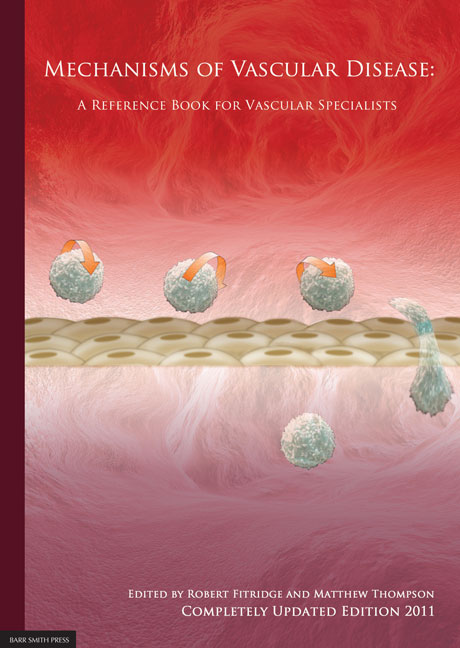Book contents
- Frontmatter
- Contents
- List of Contributors
- Detailed Contents
- Acknowledgements
- Abbreviation List
- 1 Endothelium
- 2 Vascular smooth muscle structure and function
- 3 Atherosclerosis
- 4 Mechanisms of plaque rupture
- 5 Current and emerging therapies in atheroprotection
- 6 Molecular approaches to revascularisation in peripheral vascular disease
- 7 Biology of restenosis and targets for intervention
- 8 Vascular arterial haemodynamics
- 9 Physiological Haemostasis
- 10 Hypercoagulable States
- 11 Platelets in the pathogenesis of vascular disease and their role as a therapeutic target
- 12 Pathogenesis of aortic aneurysms
- 13 Pharmacological treatment of aneurysms
- 14 Pathophysiology of Aortic dissection and connective tissue disorders
- 15 Biomarkers in vascular disease
- 16 Pathophysiology and principles of management of vasculitis and Raynaud's phenomenon
- 17 SIRS, sepsis and multiorgan failure
- 18 Pathophysiology of reperfusion injury
- 19 Compartment syndromes
- 20 Pathophysiology of pain
- 21 Post-amputation pain
- 22 Treatment of neuropathic pain
- 23 Principles of wound healing
- 24 Pathophysiology and principles of varicose veins
- 25 Chronic venous insufficiency and leg ulceration: Principles and vascular biology
- 26 Pathophysiology and principles of management of the diabetic foot
- 27 Lymphoedema – Principles, genetics and pathophysiology
- 28 Graft materials past and future
- 29 Pathophysiology of vascular graft infections
- Index
18 - Pathophysiology of reperfusion injury
Published online by Cambridge University Press: 05 June 2012
- Frontmatter
- Contents
- List of Contributors
- Detailed Contents
- Acknowledgements
- Abbreviation List
- 1 Endothelium
- 2 Vascular smooth muscle structure and function
- 3 Atherosclerosis
- 4 Mechanisms of plaque rupture
- 5 Current and emerging therapies in atheroprotection
- 6 Molecular approaches to revascularisation in peripheral vascular disease
- 7 Biology of restenosis and targets for intervention
- 8 Vascular arterial haemodynamics
- 9 Physiological Haemostasis
- 10 Hypercoagulable States
- 11 Platelets in the pathogenesis of vascular disease and their role as a therapeutic target
- 12 Pathogenesis of aortic aneurysms
- 13 Pharmacological treatment of aneurysms
- 14 Pathophysiology of Aortic dissection and connective tissue disorders
- 15 Biomarkers in vascular disease
- 16 Pathophysiology and principles of management of vasculitis and Raynaud's phenomenon
- 17 SIRS, sepsis and multiorgan failure
- 18 Pathophysiology of reperfusion injury
- 19 Compartment syndromes
- 20 Pathophysiology of pain
- 21 Post-amputation pain
- 22 Treatment of neuropathic pain
- 23 Principles of wound healing
- 24 Pathophysiology and principles of varicose veins
- 25 Chronic venous insufficiency and leg ulceration: Principles and vascular biology
- 26 Pathophysiology and principles of management of the diabetic foot
- 27 Lymphoedema – Principles, genetics and pathophysiology
- 28 Graft materials past and future
- 29 Pathophysiology of vascular graft infections
- Index
Summary
INTRODUCTION
Ischaemia-Reperfusion Injury (IRI) is defined as the paradoxical exacerbation of cellular dysfunction and death, following restoration of blood flow to previously ischaemic tissues. Reestablishment of blood flow is essential to salvage ischaemic tissues. However reperfusion itself paradoxically causes further damage, threatening function and viability of the organ. IRI occurs in a wide range of organs including the heart, lung, kidney, gut, skeletal muscle and brain and may involve not only the ischaemic organ itself but may also induce systemic damage to distant organs, potentially leading to multi-system organ failure. Reperfusion injury is a multi-factorial process resulting in extensive tissue destruction. The aim of this review is to summarise these molecular and cellular mechanisms and thus provide an insight into possible windows for effective therapeutic intervention.
ISCHAEMIA
ATP and mitochondrial function
Ischaemia occurs when the blood supply is less than the demand required for normal function, resulting in deficiencies in oxygen, glucose and other substances required for metabolism. Derangements in metabolic function begin during this ischaemic phase. Initially, glycogen breakdown by mitochondrial anaerobic glycolysis produces two molecules of adenosine triphosphate (ATP) along with lactic acid, resulting in a decrease in tissue pH, which then acts by negative feedback to inhibit further ATP production. (Figure 18.1) ATP is then sequentially broken down into adenosine diphosphate (ADP), adenosine monophosphate (AMP) and inosine monophosphate (IMP) and then further into adenosine, inosine, hypoxanthine and xanthine.
- Type
- Chapter
- Information
- Mechanisms of Vascular DiseaseA Reference Book for Vascular Specialists, pp. 331 - 350Publisher: The University of Adelaide PressPrint publication year: 2011
- 22
- Cited by

